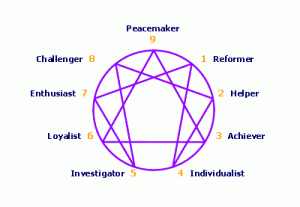If you do, then read on. If you don’t, read on too, for you will learn something about this ancient and profoundly accurate tool for understanding and engaging with the different ways in which people think, feel and intuitively ‘know’. For those of you who are familiar with the Enneagram, here is a quick refresher as I very briefly unpack what it is all about. 
Essentially, the Enneagram is a classification system that divides people into one of 9 major personality groups based on certain generalised diagnostic characteristics of their persona. Individuals in any one of these personality groups will have numerous common characteristics. Because of this commonality, by identifying indicator personality traits, one can extrapolate and predict what other characteristics a person may have. This results in a quick, practical, easy to use and remarkably accurate guide to personality profiling.
The Enneagram is often described as a personality profiling tool (and partly, it is). It is also widely used as a way in which to describe, understand and empathise with yourself and other individuals. It can be used in various different industry sectors, different departments and at all levels. It transcends culture, gender, religion and generation, making it an enormously versatile tool for raising one’s own self-awareness in order to improve one’s communication and listening skills whatever your position. So whether you want to change your work group in to a cohesive team, manage complicated work environments more effectively, adapt yourself in order to improve your sales skills, participate more authentically in a diverse department or recruit people in to your organisation more accurately, the Enneagram is your answer.
But what has been of interest to me lately is how one can also use the Enneagram to understand the collective consciousness that exists on mass whether inside a company at large, to understand a philosophy or political movement, or even to understand why cities have different ‘feels’ to them. For those who understand the Enneagram, Johannesburg is said to be a 3 city, Durban a 2 city and Cape Town a 4 city. For those who are not familiar with the Enneagram, you would probably agree that the three cities are different. Certain organisations carry an Enneagram ‘energy’. For example, I would argue that law firms have a ‘6 energy’ about them. This is not to say all lawyers are 6’s or that everybody living in Cape Town is a 4.
This has prompted me to wonder whether historical events carry Enneagram energy. For example, the mining crisis in South Africa at the moment. I have no doubt that August 2012 will be imprinted in many of our memories for years to come as a time of grave uncertainty and much economic worry as we watched the country’s main sector employer and cash generator erupt into chaos. I wonder if the mining industry is a 3 industry disintegrating to 6 during this crisis? I wonder if the National Union of Mineworkers (NUM) is an 8 energy? And I wonder if Longman, being a British company, is influenced by the 5 energy said to be that of Britain?
I also wonder whether if everyone knew the Enneagram, they could use it to resolve disputes more effectively because they would know how to
- understand themselves (by understanding our unconscious drivers)
- communicate more assertively with others and
- empathise with different perspectives more effectively.
Of course a tragedy like Marikana has a lot more to it than simply failed communication, but in a world of change, uncertainty, volatility and unpredictability, would it be wonderful to know more about the things we can control and that is: an understanding of ourselves and the environment in which we live?



Hi Saffron,
What i have always been curious about regarding the above and related theories that say they can define roughly a persons characteristics is,
My opinion is that a person transcends into different quadrants/traits at various times depending on may variables such as environment, age, education, a life changing incident, given that there are certain traits that are by default.
Therefore it is difficult to use these tools in an organisation.
I dont know if that makes sense, I dont know enough on the topic though.